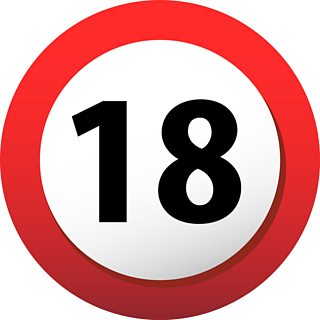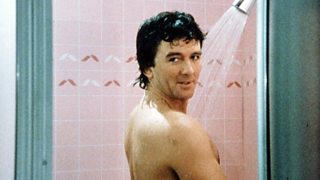Eight films that caused problems for British censors
For as long as film has existed, there have been organised efforts to censor it. Established in 1912, the British Board of Film Classification, better known as the BBFC (and formerly known as the British Board of Film Censors), has long been tasked with decreeing which movies are suitable for British audiences – and which aren't.
With more than a century of decisions has come many controversies. In this episode of BBC Radio 4's Screenshot, hosts Mark Kermode and Ellen E Jones examine how the BBFC has often found itself in the midst of ongoing discussions around art, agendas and so-called decency.
Screenshot contributor Kayleigh Donaldson looks back at some of the more notable instances where films and filmmakers have upset the board.
1. From the Manger to the Cross
The BBFC was established in 1912, largely due to the media backlash to a film released that same year. From the Manger to the Cross was a 71-minute long silent drama about the life of Jesus. Overall, this film, which feels like a precursor to the Biblical epics of Cecil B DeMille, is rather tame and pretty reverent about its subject. But the Daily Mail was outraged. "Is nothing sacred to the filmmaker?" it decried, kicking off the first documented instance of cinema being seen as blasphemous.
Is nothing sacred to the filmmaker?The Daily Mail's reaction to the 1912 Jesus biopic From the Manger to the Cross
Actual members of the clergy were less offended, having been invited to early screenings, and said the controversy was much ado about nothing. Still, the drama led to the voluntary founding of the BBFC as a way to deal with such matters without government intervention.
2. Victim
In 1961 homosexuality was still illegal in England and Wales, so Basil Dearden's Victim, a drama about a group of gay men dealing with a blackmailer threatening to out them, was incredibly daring. Moreover, the film was stridently dedicated to destigmatizing homosexuality, and it dared to depict being gay as both natural and deserving of support from a society that had outlawed it.
There is nothing graphic in Victim, but the BBFC declared that "to the great majority of cinema-goers, homosexuality is outside their direct experience and is something which is shocking, distasteful and disgusting." In giving the film an X rating, putting it in the same category of graphicness as a Hammer Horror film, they decried the film as unsuitable for most audiences. In giving their rating, after demanding several cuts to the film, they also scorned the decision to not show "sufficient counterbalance" to the idea that there's nothing wrong with being gay.

3. Mary Poppins
The BBFC allows studios and filmmakers to resubmit films to update ratings for more modern audiences. This led to Victim going from an X to a 12 in 2003. Some of these changes have inspired pushback, often as part of a wider culture war regarding children's media.
Mary Poppins, one of the true masterpieces of Walt Disney Studios, is the epitome of wholesome family entertainment on its surface. For decades, it was given the U rating, meaning it was suitable for all audiences. In February 2024, however, the BBFC reclassified Mary Poppins to a PG, noting the use of an outdated racial slur in the scene with the dancing chimney sweeps. It's a moment many viewers may not have caught on first viewing, but the BBFC decision could help them to recontextualize a beloved film and interrogate its more archaic qualities.
4. Cannibal Holocaust (and other video nasties)
When home video first became cheaper and more accessible to customers, the BBFC did not offer ratings because of a loophole in the law that allowed videos to bypass the entire process. This led to a swarm of unrated horror titles that quickly caught the attention of the infamous Mary Whitehouse.

Soon, the press and politicians alike demanded action on these so-called video nasties, which were viewed as corrupting forces on unwitting children and even dogs, according to one Tory MP. Juicy titles like Cannibal Holocaust and Driller Killer became favoured targets of the police and Whitehouse's group. The Video Recordings Act of 1984 eventually led to the BBFC becoming responsible for the certification of home releases.
5. Monty Python's Life of Brian
While the BBFC gives the rating, local authorities still had the final call on whether a film could be screened in cinemas. Largely, they follow the rating recommendation, but there have been exceptions. Many local councils refused to show The Exorcist, even though it had an X certificate.
Perhaps more contentiously, the comedy Monty Python's Life of Brian, which the BBFC had rated as AA (Suitable for ages 14+) in 1979, was banned in no fewer than 39 local authorities because of its supposedly blasphemous content. Nowadays, the film is rated 12A.
6. Crash
David Cronenberg's films have always courted controversy thanks to his depictions of body horror, but Crash is one of his most blood-free films that caught the ire of the Daily Mail.
The 1996 drama is a clinical look into a world where people find sexual satisfaction in reenacting car crashes. The BBFC passed the film without cuts and even consulted with a psychologist to see if the film was potentially dangerous (they said it wasn't.) But the Mail launched an aggressive press campaign against the film to get it banned, claiming it would encourage people to replicate the film's car crash sex acts. The film was eventually banned by Westminster Council, but eager London viewers could just walk to another borough and see it.
7. A Serbian Film
Violence continues to be a major area of concern for the BBFC (more so than its American counterpart, the MPA, where sexual content is their seeming focus). Context matters, though, hence why Gaspar Noé's Irréversible, which features a notorious nine-minute-long rape scene, passed uncut.
Actress Bel Powley told young girls to get a fake ID and go and see her 18 certificate movie The Diary of a Teenage Girl.
By contrast, A Serbian Film, a bleak exploitation movie with scenes of intense sexual violence, including one involving a baby, received 49 individual cuts. A total of four minutes and 11 seconds was cut to get the movie to an 18 rating.
8. The Diary of a Teenage Girl
While the BBFC has long been considered more understanding regarding sexual content in films than the MPA, it has not been without controversy regarding some decisions.
Director Marielle Heller was candid in her disappointment with their decision to give her film, The Diary of a Teenage Girl, an 18 rating. She had hoped that teenage audiences would be able to see her coming-of-age tale about an adolescent girl's burgeoning sexuality and her relationship with her mother's boyfriend. The film's leading actress, Bel Powley, told young girls to get a fake ID and go see the movie anyway!
To discover more about the sometimes tricky relationship between censors and filmmakers in the UK and elsewhere, listen to the episode in full.
More Screenshot articles
-
![]()
Nine of the most memorable dream sequences in film and TV
Weird, wonderful and mind-blowing portrayals of dreams on screen.
-
![]()
Nine of the most explosive divorces in cinema
The acrimonious ways movie couples split up on screen.
-
![]()
Are these the greatest double acts of all time?
Mark and Ellen remember the duos who kept us laughing.
-
![]()
Nine of the most impressive movie stunts
Celebrating the unsung art of the Hollywood stuntperson.





